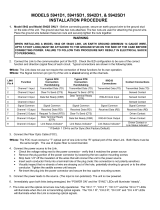
1. Application
GUID-CF75762E-73C1-40AF-8D6F-6EC3D8395982 v3
RES670 is a Phasor Measurement Unit (PMU) that
provides power system AC voltages and currents as
phasors for all voltage levels in power system networks.
Phasors are provided as real and imaginary or as
magnitude and phase angle. The reference for the phase
angle is the NavStar Global Positioning System – GPS
that also supplies highly accurate time and date. The
measured data in each PMU is time-synchronized via
Global Positioning System (GPS) receivers – with an
accuracy of one microsecond – and transmitted to
Phasor Data Concentrators (every 100 milliseconds for
example). The accurate time tagging of measurements
taken at different geographical locations makes it
possible to derive the synchronized phasor quantities
(synchrophasors). Based on synchrophasors, a number
of power system applications are available.
The PMUs are installed at substation level, and can be
connected directly to current and voltage transformers
within the substations. Each RES670 can have its own
antenna and GPS system for time synchronization
purposes or it can receive the IRIG-B signal from an
external GPS-based clock. It is also possible to have
both direct GPS and IRIG-B connection to provide time
synchronization redundancy for the PMU. RES670
streams out its synchrophasor data according to IEEE
C37.118 and/or IEEE 1344 standards for synchrophasor
data streaming and with user-selectable reporting rates.
RES670 supports reporting rates of 10, 25, 50, 100, and
200 frames per second for 50Hz system (or 10, 12, 15, 30,
60, 120, and 240 frames per second for 60Hz system).
Each RES670 can communicate its synchrophasor data
to up to eight independent clients over TCP and/or six
independent UDP channels (unicast/multicast),
simultaneously. More information is available in RES670
Application Manual under Wide Area Measurement
System section.
In addition to the synchrophasor communication
standard (IEEE 1344, IEEE C37.118), RES670 is also
compliant to IEC 61850-8-1 standard for integration to
substation automation systems and exchange of GOOSE
messages, when necessary. RES670 is able to
communicate over IEC 62439-3 PRP for redundant
station bus communication for both IEEE C37.118 and
IEC 61850-8-1, simultaneously.
Figure 1 shows an example of a system architecture for a
Wide Area Monitoring System (WAMS). PMUs are the
building blocks for a WAMS. The architecture of a WAMS
consists of the following main components:
•
PMU Phasor Measurement Unit, including all
accessories for time synchronization
• TCP/IP and/or UDP/IP communication network infra-
structure
• PDC Phasor Data Concentrator, including wide area
applications
Substation 1
Visualization
(Applications)
Interface to
SCADA / EMS
Data Storage and Event
Driven Archiving
Gateway to other Utilities
IEC140000114-1-en.ai
Phasor Data Concentrator
PDC
Substation 2 Substation 3 Substation N
Router Router Router Router
TCP/IP communication network
PMU protocol IEEE C37.118
PMU PMU PMU PMUPMU PMU
GPS GPS GPSGPS GPS GPS
IEC140000114 V1 EN-US
Figure 1. Wide Area Monitoring System architecture — overview
A Wide Area Monitoring System collects, stores,
transmits and provides ways to analyze critical data
from key points across the power networks and over
large geographical areas. The architecture of the WAMS
can provide a scalable solution, from small installations
for data collection and basic visualization (PDC) to
larger systems with intelligent monitoring using wide
area applications. The Wide Area Monitoring
applications are designed to detect abnormal system
conditions and evaluate large area disturbances in order
to preserve system integrity and maintain acceptable
power system performance.
The WAMS is configured in a way to acquire
synchrophasor data from several PMUs. Based on the
data collected in the PDCs, WAMS is able to present the
state of the grid to the power system operator, and to
provide monitoring of the power system based on real-
time measurements and the results of on-line
applications. In addition, the data available from PDCs
enables off-line analysis of the power system for post-
disturbance assessments. It is possible to communicate
the PMU measurements and the results of the advanced
applications to SCADA/EMS systems as a way to
improve the supervision of the system, providing the
operator with a clear indication how likely the system is
to collapse, thus giving the possibility to react in time.
Forcing of binary inputs and outputs is a convenient way
to test wiring in substations as well as testing
configuration logic in the IEDs. Basically it means that all
Phasor measurement unit RES670 2.1 IEC
1MRK 511 367-BEN D
Issued: March 2019
Revision: D
ABB 3




















